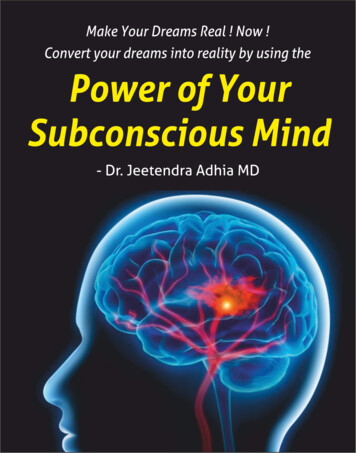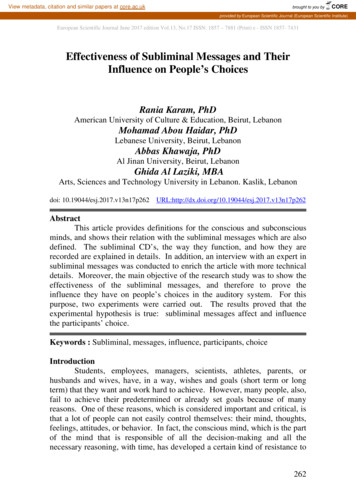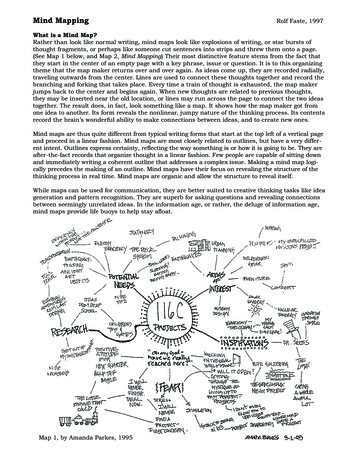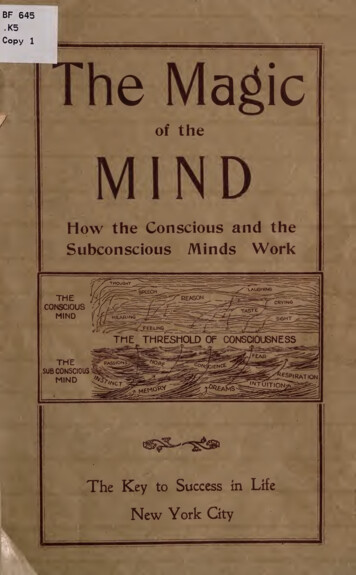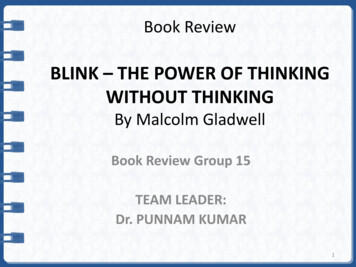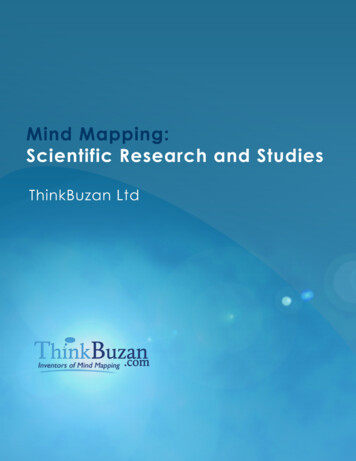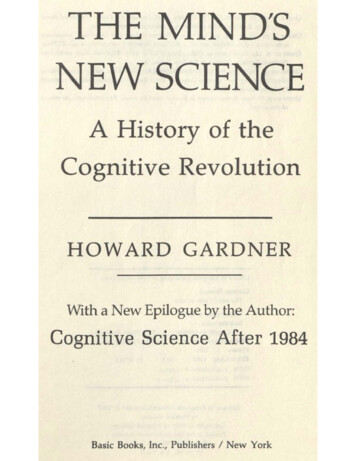
Transcription
THE MIND'SNEW SCIENCEA History of theCognitive RevolutionHOW ARD GARDNERWith a New Epilogue by the Author:Cognitive Science After 1984Basic Books, Inc., Publishers I New York
Quotes on pp. 6688 from H. Putrwn, Mini, u"l"qt 1ni R111lily: Phi/OS()phial P,,pns,1111L 1 , 1975. Reprinted with pmniasion, Cambridge University Press.Quotes on pp. :w, 2-4 132,295 from N . Wiener, Cybmttlics, 11r CDntrol .,,, Comm1m1t111ionin llu Ani11111l 1ni flu MtuhiM, 2nd ed., 1 1/ 1948. Reprinted with permmion, MIT Press.Quote on p . .J.4-4 fromMiller, SI.Its of Mini, 1983. Reprinted with permiHion,Books, a Division ofHouse, Inc.Quotes on pp. 72, 73, 74, 75,85 from Richard Rorty, PhilDSCphy 1ni flit Mirrvr of N11hm.1979 by Princeton University Press. Excerpts reprinted with permission ofPrinceton University Press.Quote on p. 70 from Jerome Bruner, In !Nflrth of Mini (in press). Reprinted with permiuionof the author.Library of Congress Catlloging in Publication DataGardner, Howard.The mind's new science.Bibliography: p. 401 .Includes index.1. Cognition-History. 2. Cognltion-ResearchMethodology-History. 3. Artifidll intelligence-History. I. Title.BF311.G339 1985153ISBN 0-465-04634-7 (cloth)ISBN 0-465-04635-5 (paper)Epilogue to Paperback Edition Copyright 1987by Howard GardnerCopyright 1985 by Howard GardnerPrinted in the United States of Americ.iDesigned by Vincent Torre89 90 HC 9 8 7 6 5
3Cognitive Science:The First DecadesA Consensual BirthdateSeldom have amateur historians achieved such consensus. There has beennearly unanimous agreement among the surviving principals that cognitivescience was officially recognized around 1956. The psychologist George A.Miller (1979) has even fixed the date, 11 September 1956.Why this date? Miller focuses on the Symposium on InformationTheory held at the Massachusetts Institute of Technology on 10-12 September 1956 and attended by many leading figures in the communicationand the human sciences. The second day stands out in Miller's mindbecause of two featured papers. The first, presented by Allen N ewell andHerbert Simon, described the " Logic Theory Machine," the first completeproof of a theorem ever carried out on a computing machine. The secondpaper, by the young linguist Noam Chomsky, outlined "Three Models ofLanguage." Chomsky showed that a model of language production derivedfrom Claude Shannon's information- theoretical approach could not possibly be applied successfully to " natural language," and went on to exhibithis own approach to grammar, based on linguistic transformations. AsMiller recalls, " Other linguists had said language has all the formal precisions of mathematics, but Chomsky was the first linguist to make good onthe claim. I think that was what excited all of us" (1979, p. 8). Not incidentally, that day George Miller also delivered a seminal paper, outlining hisclaim that the capacity of human short-term memory is limited to approximately seven entries. Miller summed up his reactions:28
CognifirJt Scimce: The Firs! DecadesI went away from the Symposium with a strong conviction, more intuitivethan rational. that human experimental psychology, theoretical linguistics, andcomputer simulation of cognitive processes were all pieces of a larger whole, andthat the future would see progressive elaboration and coordination of their sharedconcerns. I have been working toward a cognitive science for about twenty yearsbeginning before I knew what to call it. (1979, p. 9)Miller's testimony is corroborated by other witnesses. From the ranksof psychology, Jerome Bruner declares, "New metaphors were coming intobeing in those mid-1950s and one of the most compelling was that ofcomputing. . . . My "Generation" created and nurtured the CognitiveRevolution-a revolution whose limits we still cannot fathom" (1983, pp.274, 277). Michael Posner concludes, "This mix of ideas about cognitionwas ignited by the information processing language that arrived in psychology in the early 1950s" (Posner and Shulman 1979, p. 374}. AndGeorge Mandler suggests:For reasons-that are obscure at present, the various tensions and inadequaciesof the first half of the twentieth century cooperated to produce a new movementin psychology that first adopted the label of information processing and afterbecame known as modem cognitive psychology. And it all happened in the fiveyear period between 1955 and 1960. Cognitive science started during that five yearperiod, a happening that is just beginning to become obvious to its practitioners.{1981, p. 9)Finally, in their history of the period, computer scientists Allen Newell andHerbert Simon declare:Within the last dozen years a general change in scientific outlook has ocCUrred, consonant with the point of view represented here. One can date the changeroughly from 1956: in psychology, by the appearance of Bruner, Goodnow,Austin's Study of Thinking and George Miller's "The magical number seven"; mlinguistics, by Noam Chomsky's "Three models of language"; and in computerscience, by our own paper on the Logical Theory Machine. (1972, P· 4)This impressive congruence stresses a few seminal publications, emanating (not surprisingly perhaps) from the same small group of investigators. ln fact, however, the list of relevant publications is almost endless.As far as general cognitive scientific publications are concerned, John vonNeumann's posthumous book, The Computer and the Brain (1958), shouldhead the list. In this book-actually a set of commissioned lectures whichVon Neumann became too ill to deliver-the pioneering computer scientistdeveloped many of the themes originally touched upon in his Hixon Symposium contribution. He included a discussion of various kinds of comput-29
IITHE COGNITIVE REVOLUTIONers and analyzed the idea of a program, the operation of memory in computers, and the possibility of machines that replicate themselves.Relevant research emanated from each of the fields that I have designated as contributing cognitive sciences. The witnesses I have just quotednoted the principal texts in the fields of psychology, linguistics, and artificial intelligence, and many more entries could be added. Neuroscientistswere beginning to record impulses from single neurons in the nervoussystem. At M.l.T., Warren McCulloch's research team, led by the neurophysiologists Jerome Lettvin and Humberto Maturana, recorded from theretina of the frog. They were able to show that neurons were responsiveto extremely specific forms of information such as " bug-like" small darkspots which moved across their receptive fields, three to five degrees inextent. Also in the late 1950s, a rival team of investigators, David Hubeland Torsten Wiesel at Harvard, began to record from celJs in the visualcortex of the cat. They located nerve cells that responded to specific information, including brightness, contrast, binocularity, and the orientation oflines. These lines of research, eventually honored in 1981 by a Nobel Prize,called attention to the extreme specificity encoded in the nervous system.The mid 1950s were also special in the field of anthropology. At thistime, the first publications by Harold Conklin, Ward Goodenough, andFloyd Lounsbury appeared in the newly emerging field of cognitive anthropology, or ethnosemantics. Researchers undertook systematic collection of data concerning the naming, classifying, and concept-forming abilities of people living in remote cultures, and then sought to describe informal terms the nature of these linguistic and cognitive practices. Thesestudies documented the great variety of cognitive practices found aroundthe world, even as they strongly suggested that the relevant cognitiveprocesses are similar everywhere.In addition, in the summer of 1956, a group of young scholars, trainedin mathematics and logic and interested in the problem-solving potentialsof computers, gathered at Dartmouth College to discuss their mutual interests. Present at Dartmouth were most of the scholars working in whatcame to be termed "artificial intelligence," including the four men generally deemed to be its founding fathers: John McCarthy, Marvin Minsky,Allen Newell, and Herbert Simon. During the summer institute, thesescientists, along with other leading investigators, reviewed ideas for programs that would solve problems, recognize patterns, play games, andreason logically, and laid out the principal issues to be discussed in comingyears. Though no synthesis emerged from these discussions, the participants seem to have set up a permanent kind of "in group" centered at the.points m t c text.30references to these lines of research will be provided at appropriate
Cognifivt Science: The First DecadesM.l.T., Stanford, and Carnegie-Mellon campuses. To artificial intelligence,this session in the summer of 1956 was as central as the meeting at M.I.T.among communication scientists a few months later.Scholars removed from empirical science were also pondering theimplications of the new machines. Working at Princeton, the Americanphilosopher Hilary Putnam (1960) put forth an innovative set of notions.As he described it, the development of Turing-machine notions and theinvention of the computer helped to solve-or to dissolve-the classicalmind-body problem. It was apparent that different programs, on the sameor on different computers, could carry out structurally identical problemsolving operations. Thus, the logical operations themselves (the "software") could be described quite apart from the particular "hardware" onwhich they happened to be implemented. Put more technically, the"logical description" of a Turing machine includes no specification of itsphysical embodiment.The analogy to the human system and to human thought processeswas clear. The human brain (or "bodily states") corresponded to the computational hardware; patterns of thinking or problem solving ("mentalstates") could be described entirely separately from the particular constitution of the human nervous system. Moreover, human beings, no less thancomputers, harbored programs; and the same symbolic language could beinvoked to describe programs in both entities. Such notions not onlyclarified the epistemological implications of the various demonstrations inartificial intelligence; they also brought contemporary philosophy and empirical work in the cognitive sciences into much closer contact.One other significant line of work, falling outside cognitive science asusually defined, is the ethological approach to animal behavior which hadevolved in Europe during the 1930s and 1940s thanks to the efforts ofKonrad Lorenz (1935) and Niko Tinbergen (1951). At the very time thatAmerican comparative psychologists were adhering closely to controlledlaboratory settings, European ethologists had concluded that animalsshould be studied in their natural habitat. Observing carefully under thesenaturalistic conditions, and gradually performing informal experiments onthe spot, the ethologists revealed the extraordinary fit between animellsand their natural environment, the characteristic Umwelt (or world view)of each species, and the particular stimuli (or releasers) that catalyze dramatic developmental milestones during "critical" or "sensitive" periods.Ethology has remained to some extent a European rather than an Americanspecialty. Still, the willingness to sample wider swaths of behavior innaturally occurring settings had a liberating influence on the types ofconcept and the modes of exploration that came to be tolerated in cognitivestudies.31
IITHE COGNITIVE REVOLUTIONThe 1960s: Picking Up SteamThe seeds planted in the 1950s sprouted swiftly in the next decade. Governmental and private sources provided significant financial support. Setting the intellectual tone were the leading researchers who had launchedthe key lines of study of the 1950s, as well as a set of gifted students whowere drawn to the cognitive fields, much in the way that physics andbiology had lured the keenest minds of earlier generations. Two principalfigures in this "selling of cognition" were Jerome Bruner and GeorgeMiller, who in 1960 founded at Harvard the Center for Cognitive Studies.The Center, as story has it, began when these two psychologists approached the dean of the faculty, McGeorge Bundy, and asked him to helpcreate a research center devoted to the nature of knowledge. Bundy reportedly responded, "And how does that differ from what Harvard Universitydoes?'' (quoted in Bruner 1983, p. 123). Bundy gave his approval, andBruner and Miller succeeded in getting funds from the Carnegie Corporation, whose president at that time, the psychologist John Gardner, wassympathetic to new initiatives in the behavioral sciences.Thereafter, for over ten years, the Harvard Center served as a localewhere visiting scholars were invited for a sabbatical, and where graduateand postdoctorate students flocked in order to sample the newest thinkingin the cognitive areas. A list of visitors to the Center reads like a Who'sWho in Cognitive Science: nearly everyone visited at one time or another,and many spent a semester or a year in residence. And while the actualprojects and products of the Center were probably not indispensable forthe life of the field, there is hardly a younger person in the field who wasnot influenced by the Center's presence, by the ideas that were bandiedabout there, and by the way in which they were implemented in subsequent research. Indeed, psychologists Michael Posner and Gordon Shulman (1979) locate the inception of the cognitive sciences at the HarvardCenter.During the 1960s, books and other publications made available theideas from the Center and from other research sites. George Millertogether with his colleagues Karl Pribram, a neuroscientist, and EugeneGalanter, a mathematically oriented psychologist-opened the aecadewith a book that had a tremendous impact on psychology and allied fields-a slim volume entitled Plans and the Structure of Behavior (1960) . In it theauthors sounded the death knell for standard behaviorism with its discredited reflex arc and, instead, called for a cybernetic approach to behavior interms of actions, feedback loops, and readjustments of action in the light32
Cognitive Science: Tht First Decadesof feedback. To replace the reflex arc, they proposed a unit of activitycalled a "TOTE unit" (for "Test-Operate-Test-Exit"): an important property of a TOTE unit was that it could itself be embedded within thehierarchical structure of an encompassing TOTE unit. As a vehicle forconceptualizing such TOTE units, the authors selected the computer withits programs. If a computer could have a goal (or a set of goals), a meansfor carrying out the goal, a means for verifying that the goal has beencarried out, and then the option of either progressing to a new goal orterminating behavior, models of human beings deserved no less. The computer made it legitimate in theory to describe human beings in terms ofplans (hierarchically organized processes), images (the total availableknowledge of the world), goals, and other mentalistic conceptions; and bytheir ringing endorsement, these three leading scientists now made it legitimate in practice to abandon constricted talk of stimulus and response infavor of more open-ended, interactive, and purposeful models.The impact of this way of thinking became evident a few years laterwhen textbooks in cognitive psychology began to appear. By far the mostinfluential was Cognilivt Psychology by the computer-literate experimentalpsychologist Ulric Neisser (1967). Neisser put forth a highly "constructive" view of human activity. On his account, all cognition, from the firstmoment of perception onward, involves inventive analytic and synthesizing processes. He paid tribute to computer scientists for countenancing talkof an "executive" and to information scientists for discussing accession,processing, and transformation of data. But at the same time, Neisserresisted uncritical acceptance of th e computer-information form of analysis. In his view, objective calculation of how many bits of information canbe processed is not relevant to psychology, because human beings areselective in their attention as a pure channel such as a telephone cannotbe. Neisser expressed similar skeptical reservations about the claims surrounding computer programs:None of (these programs] does even remote justice to the complexity ofhuman mental processes. Unlike men, "artificially intelligent" programs tend to besingle minded, undistractable, and unemotional. . This book can be construedas an extensive argument against models of this kind, and also against othersimplistic theories of the cognitive processes. (1967, p. 9)After Neisser, it was possible to buy the cognitive science approach ingeneral and still join into vigorous controversies with "true believers."Enthusiasts of the power of simulation were scarcely silent during thisperiod. ln his 1969 Compton lectures, The Sciences of !he Arlificial, HerbertSimon provided a philosophical exposition of his approach: as he phrased33
ITHE COGNITIVE REVOLUTIONit, both the computer and the human mind should be thought of as "symbol systems"-physical entities that process, transform, elaborate, and, inother ways, manipulate symbols of various sorts. And, in 1972, AllenNewell and Herbert Simon published their magnum opus, the monumentalHuman Problem Solving, in which they described the "general problem solver"programs, provided an explanation of their approach to cognitive studies,and included a historical addendum detailing their claims to primacy inthis area of study.Textbooks and books of readings were appearing in other subfields ofcognitive science as well. An extremely influential collection was JerryFodor and Jerrold Katz's collection, The Structure of Language (1964), whichanthologized articles representing the Chomskian point of view in philosophy, psychology, and linguistics, and attempted to document why thisapproach, rather than earlier forays into language, was likely to be theappropriate scientific stance. In artificial intelligence, Edward Feigenbaumand Julian Feldman put out a collection called Computers and Thought (1963),which presented many of the best-running programs of the era; while theircollection had a definite "Carnegie slant," a rival anthology, Semanfic Information Processing, edited by Marvin Minsky in 1968, emphasized the M.l.T.position. And, in the area of cognitive anthropology, in addition to influential writings by Kimball Romney and Roy D'Andrade (1964), StephenTyler's textbook Cognitive Anthropology made its debut in 1969.But by 1969, the number of slots in short-term memory had beenexceeded-without the benefit of chunking, one could no longer enumerate the important monographs, papers, and personalities in the cognitivesciences. (In fact, though my list of citations may seem distressingly long,I have really only scratched the surface of cognitive science, circa 1970.)There was tremendous activity in several fields, and a feeling of definiteprogress as well. As one enthusiastic participant at a conference declared:We may be at the start of a major intellectual adventure: somewhere comparable to the position in which physics stood toward the end of the Renaissance, withlots of discoveries waiting to be made and the beginning of an inkling of an ideaof how to go about making them. It turned out, in the case of the early developmentmoder n physics that the advancement of the science involved developing newofsophistication: new mathematics, a new ontology, and a newof sC1enhfic method. My guess is that the same sort of evolution is requiredm thecase (and, by the way, in much the same time scale). Probably now,as then, it will be an uphill battle against obsolescent intellectual and institutionalhabits. (Sloan Foundation 1976, p. 10}When theof activity in a field has risen to this point, withan aura of excitement about impending breakthroughs, human beings34
Cognitive Science: The Firs/ Decadesoften found some sort of an organization or otherwise mark the newenterprise. Such was happening in cognitive science in the early and middle 1970s. The moment was ripe for the coalescing of individuals, interests,and disciplines into an organizational structure.The Sloan InitiativeAt this time, fate intervened in the guise of a large New York-based privatefoundation interested in science-the Alfred P. Sloan Foundation. TheSloan Foundation funds what it terms "Particular Programs," in which itinvests a sizable amount of money in an area over a few years' time, in thehope of stimulating significant progress. In the early 1970s, a ParticularProgram had been launched in the neurosciences: a collection of disciplinesthat explore the nervous system-ranging from neuropsychology andneurophysiology to neuroanatomy and neurochemistry. Researchersdrawn from disparate fields were stimulated by such funding to explorecommon concepts and common organizational frameworks. Now Sloanwas casting about for an analogous field, preferably in the sciences, inwhich to invest a comparable sum.From conversations with officers of the Sloan Foundation, and fromthe published record, it is possible to reconstruct the principal events thatled to the Sloan Foundation's involvement with cognitive science. In early1975, the foundation was contemplating the support of programs in severalfields; but by late 1975, a Particular Program in the cognitive sciences wasthe major one under active consideration. During the following year, meetings were held where major cognitive scientists shared their views. Possibly sensing the imminent infusion of money into the field, nearly everyscientist invited by the Sloan Foundation managed to juggle his or herschedule to attend the meetings. Though there was certainly criticismvoiced of the new cognitive science movement, most participants (whoWere admittedly interested parties) stressed the promise of the field and theneed for flexible research and training support.While recognizing that cognitive science was not as mature asneuroscience at the time of the foundation's commitment to the latterfield, officers concluded that "nonetheless, there is every indication,confirmed by the many authorities involved in primary explorations, thatmany areas of the cognitive sciences are converging, and, moreover, thereis a correspondingly important need to develop lines of communication35
IITHE COGNITIVE REVOLUTIONfrom area to area so that research tools and techniques can be shared inbuilding a body of theoretical knowledge" (Sloan Foundation 1976, p. 6).After deliberating, the foundation decided to embark on a five-to-sevenyear program, involving commitments of up to fifteen million dollars.(This commitment was ultimately increased to twenty million dollars.)The investment took the form, initially, of small grants to many researchinstitutions and, ultimately, of a few large- scale grants to major universities.Like the spur provided by the Macy Foundation a generation earlier,the Sloan Foundation's initiative had a catalytic effect on the field. As morethan one person quipped, "Suddenly I woke up and discovered that I hadbeen a cognitive scientist all of my life." In short order the journal CogniliutScience was founded-its first issue appearing in January 1977; and soonthereafter, in 1979, a society of the same name was founded . DonaldNorman of the University of California in San Diego was instrumental inboth endeavors. The society held its first annual meeting, amid great fanfare, in La Jolla, California, in August 1979. Programs, courses, newsletters,and allied scholarly paraphernalia arose around the country and abroad.There were even books about the cognitive sciences, including a popularaccount, The Universe Within, by Morton Hunt (1982) and my own historicalessay, also supported by the Sloan Foundation.Declaring the birth of a field had a bracing effect on those who discovered that they were in it, either centrally or peripherally, but by no meansensured any consensus, let alone appreciable scientific progress. Patronsare almost always necessary, though they do not necessarily suffice, tofound a field or create a consensus. Indeed, tensions about what the fieldis, who understands it, who threatens it, and in what direction it ought togo were encountered at every phase of the Sloan Foundation's involvement(and have continued to be to this day).Symptomatic of the controversy engendered by the Sloan Foundation's support of research in cognitive science was the reaction to a reportcommissioned by the foundation in 1978. This State of the Art Report(soon dubbed "SOAP" for short) was drafted by a dozen leading scholarsin the field, with input from another score of advisers. In the view of theauthors, "What has brought the field into existence is a common researchobjective: to discover the representational and computational capacities ofthe mind and their structural and functional representation in the brain"p.authors prepared a sketch of the interrelations among thesix constituent fields-the cognitive hexagon, as it was labeled. Throughthe use of unbroken and broken lines, an effort was made to indicate thebetween fields which had already been forged, and to suggestthe kinds of connection which could be but had not yet been effected.36
CognifiTJt Science: The Rrsf DecadesConntdions among !ht Cognitive ScienctSKn:Unbroken lines strong interdisciplinary tiesBroken lines weak interdisciplinary tiesIn my view, the authors of the SOAP document made a serious effortto survey principal lines of research and to provide a general charter forWork in cognitive science, setting forth its principal assumptions. Then,using the example of how individuals from different cultures give namesto colors, these authors illustrated how different disciplines combine theirinsights. (I'll flesh out this example of color naming in chapter 12.) However, the community-at-large adopted a distinctly negative view of thereport. In fact, such virulent opposition was expressed by so many readersthat, counter to original plans, the document was never published. I thinkthis negative reaction came from the fact that each reader approached thedoeument from the perspective of his or her own discipline and researchprogram. In an effort to be reasonably ecumenical, the authors simplyensured that most readers would find their own work slighted. Moreover,there is as yet no agreed-upon research paradigm-no consensual set ofassumptions or methods--and so cognitive scientists tend to project theirown favorite paradigms onto the field as a whole. In view of these factors,it was probably not possible in 1978 to write a document that would havewon the support of a majority of cognitive scientists.It would be desirable, of course, for a consensus mysteriously to37
IITHE COGNITIVE REVOLUTIONemerge, thanks to the largesse of the Sloan Foundation, or for some latterday Newton or Darwin to bring order into the field of cognitive science.In the absence, however, of either of these miraculous events, it is left tothose of us who wish to understand cognitive science to come up with ourown tentative formulation of the field. In the opening chapter of this book,I presented a working definition of cognitive science and alluded to fivekey components of the field . Now that I have sketched out some of theintellectual forces that led to the launching of cognitive science some threedecades ago, I want to revisit these themes in somewhat more detail, inorder to consider some of their implications as well as some of theirproblematic aspects. I will then conclude this introductory part by describing the paradox and the challenge standing at the center of contemporarycognitive science.Key Features of Cognitive Scienceln my own work I have found it useful to distinguish five features or"symptoms" of cognitive science: the first two of these represent the "coreassumptions" of the field, while the latter three represent methodologicalor strategic features. Not only are these ideas common to most "strongversions" of cognitive science, but they also serve as specific points ofcontention for its critics. I shall list each of these characteristics and thenindicate certain lines of criticism put forth by those most antagonistic tocognitive science. These criticisms (as voiced by their most vocal adherents) will be expanded upon at appropriate points in the book and reviewed in my concluding chapter.RepresenfafionsCognitive science is predicated on the belief that it is legitimate-infact, necessary-to posit a separate level of analysis which can be calledthe "level of representation." When working at this level, a scientist trafficsin such representational entities as symbols, rules, images-the stuff ofrepresentation which is found between input and output-and in addition,explores the ways in which these representational entities are joined,transformed, or contrasted with one another. This level is necessary inorder to explain the variety of human behavior, action, and thought.In opting for a representational level, the cognitive scientist is claimingthat certain traditional ways of accounting for human thought are inadeJ8
Cognitive Science: The First Decadesquate. The neuroscientist may choose to talk in terms of nerve cells, thehistorian or anthropologist in terms of cultural influences, the ordinaryperson or the writer of fiction in terms of the experiential or phenomenological level. While not questioning the utility of these levels for variouspurposes, the cognitive scientist rests his discipline on the assumption that,for scientific purposes, human cognitive activity must be described i n ]terms symbols, schemas, images, ideas, and other forms of mental representation.ln terms of ordinary language, it seems unremarkable to talk of humanbeings as having ideas, as forming images, as manipulating s
sions of mathematics, but Chomsky was the first linguist to make good on the claim. I think that was what excited all of us" (1979, p. 8). Not inciden-tally, that day George Miller also delivered a seminal paper, outlining his claim that the capacity of human shor


